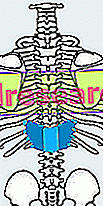See also: intestinal flu
Influenza is an acute, highly contagious and epidemic infectious disease; it affects the upper and lower respiratory tract, manifesting itself with symptoms such as fever, cough, sneezing, malaise and musculoskeletal pain.
Influenza virus
The microorganisms responsible for the flu are viruses belonging to the Ortomixoviridiae family, which includes three genera: the type A influenza, more common, the type B influenza and the less common C.

The alteration of the antigenic structure of the virus gives rise to viral strains against which there is no resistance from the population and, therefore, induces the development of epidemics limited to the winter months (viruses A and B), or even pandemics (virus A) that appear every 10-30 years with dramatic results (in that of 1918, the "Spanish" influence claimed over 75 million victims).
Contagion
The infection is transmitted rapidly by air, using droplets of saliva emitted by coughing, sneezing and conversations. This type of transmission occurs above all among individuals that populate enclosed spaces, but there is also a contagion of an indirect nature, since the virus can persist for hours outside the body, especially in cold and low humidity conditions. In general, influenza viruses resist for a few weeks at temperatures close to 0-4 ° C, while they are inactivated by heat, UV rays and common disinfectants.
Flu symptoms
To learn more: Flu symptoms
Influenza is a disease with a rather short incubation time (from a few hours to three days); occurs with a non-specific symptomatology, characterized by cold, fever (moderate to high), intense headache (especially frontal), diffuse myalgia, loss of appetite and state of prostration; almost immediately the respiratory symptoms take over, including rhinorrhea, sneezing, watery eyes and cough, at first dry, then catarrhal with mucous or mucopurulent sputum (therefore with traces of pus). These general symptoms are sometimes accompanied by symptoms affecting the gastrointestinal tract (nausea, vomiting and diarrhea), especially in children.
Complications
Influenza is an infectious disease with a generally benign course (it resolves positively in 3-6 days, leaving room for an exhaustion that lasts up to a few weeks). At other times it can present itself in a particularly attenuated form or become complicated with bacterial superinfections. Influenza viruses, in fact, destroy the cells of the respiratory mucosa, favoring the penetration of bacterial pathogens, in turn responsible for bronchitis, pneumonia, bronchopneumonia, otitis and sinusitis. All these complications are more frequent in individuals with chronic diseases (asthma, diabetes, renal, cardiovascular and dysmetabolic diseases), in the elderly, in children and in the immunocompromised; for this reason, the population at risk should undergo an annual vaccination against influenza.
The symptoms of pneumonia, which include productive cough with expectoration, high fever and difficult and painful breathing, should prompt the individual to request rapid medical intervention.
Prevention
Prevention of influenza is carried out in the first instance by keeping one's immune system healthy, through a healthy and balanced diet associated with an active lifestyle and optimal management of daily stresses. Very important are the basic hygiene rules, such as bringing your hands to your mouth when you cough and sneeze, always washing them before meals, after going to the toilet and on all occasions listed in this article.
Deepening: Flu vaccine
Influenza care and therapy
To learn more: Drugs for the treatment of influenza
In the absence of complications, the therapy is symptomatic and includes, first of all, rest, generous administration of liquids, consumption of easily digestible meals and, if necessary, the use of analgesic (painkillers) and antipyretic drugs (to bring down the fever) . In this regard, we would like to point out that the use of salicylates (hence the classic aspirin) is contraindicated under the age of 16 (due to the risk of developing Reye's syndrome) and how fever has a favorable effect on the course of the disease (obviously when it is particularly high or suffer from it they are individuals at risk of complications, it must still be lowered).
Some antiviral drugs, such as amantadine and rimantadine, can reduce the severity and duration of the flu, provided they are administered at the first signs of symptoms (within the first 48 hours of illness); recently good results have been obtained with zanamivir therapy, a drug to be taken by inhalation, always within the first 48 hours of illness.
Specific antibiotics can be prescribed by the doctor in the presence of complications, but they are completely ineffective in the therapy of the flu (considering its viral and non-bacterial nature), if not even harmful (further weaken the immune defenses).
See also: Nutrition, medicinal herbs and flu



